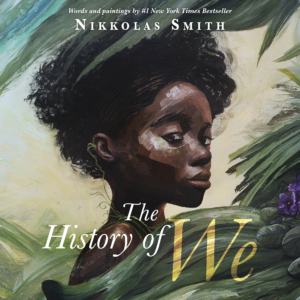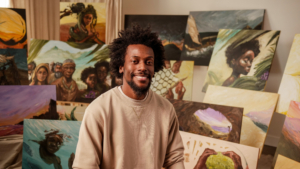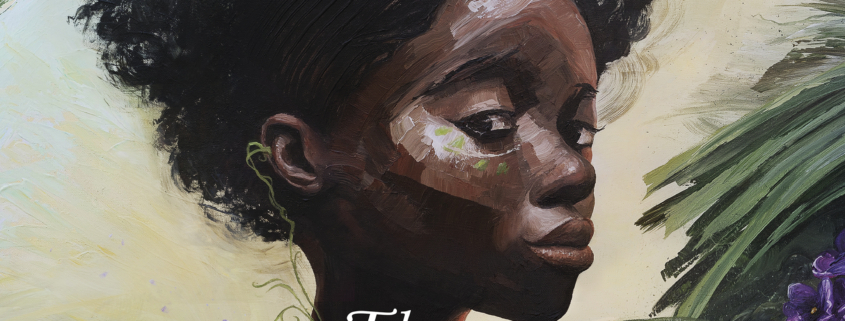The History of We by Nikkolas Smith
We welcome Nikkolas Smith to the blog today sharing answers to a few questions about The History of We, published by One World Publications.

The History of We takes us all the way back to humanity’s beginnings in Africa. What inspired you to tell this story?
Growing up, the textbooks I had in school skipped over hundreds of thousands of years of modern human ingenuity in Africa, and the foundational scientific fact that all human life began in Africa. I wanted this book to address this historical cover-up.
Additionally, a huge moment of inspiration for this book came a few years ago when I made an art piece of a Black American child named Al Bright from the 1950’s, who was banned from swimming with his baseball teammates because of racism. I thought to myself, there are so many stories of Black children who because of the racist history of America, were never taught how to swim, and their parents/grandparents weren’t allowed to swim.
I wished I could’ve told those kids, “Did you know that The FIRST swimmers in human history looked just like you? Your ancestors invented swimming. Don’t ever let anyone tell you you can’t do anything”
And since I can’t tell that face to face to every marginalized child, I thought why not make a book about those kids’ first ancestors! The ones who are actually all our first ancestors. So that led me ask, perhaps I can explore what the beginning of modern humanity looked like as a whole: the first artists, inventors, healers, agriculturalists, explorers, and more.
The illustrations are beautiful! You have hand-painted them using sticks, leaves, sponges, and even your fingers. What led you to choose these techniques for The History of We?
I wanted it to have every emotion of the first modern human beings on earth: the laughter, the joy, the fear, the worry, the skill, the courage, the curiosity, everything. So as I’m putting paint on my hands, brushes, sticks, or any object that I can find and throwing it on a canvas, I wanted it to mirror our earliest ancestors who were creating masterpieces of their day. This was in the Blombos Cave in South Africa, where the earliest known human art was uncovered.
Was there one painting used in the book that was especially meaningful to create and why? (or if this is too hard to answer – do you have a favourite painting/illustrations and why?
There are so many paintings from The History of We that I love, from the explorers, to the astronomers. My absolute favorite might be the cover of the book, featuring my interpretation of humanity’s oldest known modern human ancestor, whom I refer to as Queen Mother or MAWA. I wanted to capture her image with tons of brushstroke detail, and focus on getting her look right, peering into the eyes of everyone in the world, saying, “do you see me? Have I been written out of the history books? Can we come back to this point in history collectively on the basis of unity?”

Photo Credit:© Vanessa Crocini
How has your own journey shaped the way you tell stories about history, identity, and community?
As a Black child growing up in Texas in the United States, I saw my fair share of racism and injustice. I went on to study in the Master of Architecture program at Hampton University in Virginia, and following that, worked 11 years as a theme park designer in California. Living in these various parts of America gave me an important perspective on how different cultures in a melting pot coexist, or fail to. With every art project I take on, I have a greater appreciation for attention to personal detail as a Black creative, diversity in society, and visual storytelling. They are life lessons that have made my creative art explorations even more complex, and hopefully more meaningful.
What do you hope school children and families will take away from reading The History of We together?
I love that this book is a fact-filled slice of human history that all ages can gather around and enjoy, helping us to all look at humanity’s collective origin story and reminding us of the truth that we are globally a family of extended cousins, and that there is much more connecting us than what separates us.
How can schools use this book to spark important conversations?
I see this book truly as a form of educational justice, pointing to a large piece of well documented history that’s been left out of the history books. It highlights decades of scientifically proven research that shows that every person on Earth can be traced back to a handful of traveling tribes from Africa. It’s an important lesson regarding the Middle Paleolithic era that should be taught in every history, geography, and anthropology class.
You describe yourself as an “artivist.” What role do you think art can play in inspiring positive change?
I see Artivism as a tool that calls out the broken bones of the world and helps people see a new perspective, motivating them to create a positive change. It is an artistic wake up call. The beautiful result is that it prompts audiences to take concrete steps to make a real difference, such as changing toxic behavior, protesting, signing petitions, or calling local politicians to demand change.
Beyond The History of We, what creative journeys are you exploring at the moment, and where do you see your art and activism taking you next?
I’m excited about my next picture book “That Beautiful Mind” in collaboration with Tami Charles, and exploring new stories in the coming years that focus on visualizing how to heal what is broken in society. My weekly Sunday Sketch series is still ongoing in its 12th year, and I love that every week I can find creative ways to address current events and inspire people to take steps toward change-making.



